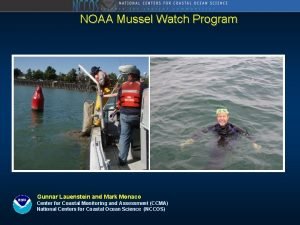Freshwater pearl mussel Margaritifera margaritifera Host specificity and

- Slides: 1

Freshwater pearl mussel, Margaritifera margaritifera: Host specificity and genetic variation in Norway BJØRN MEJDELL LARSEN & STEN KARLSSON Norwegian Institute for Nature Research (NINA), NO-7485 Trondheim, Norway; bjorn. larsen@nina. no INTRODUCTION The endangered freshwater pearl mussel, Margaritifera margaritifera, requires Atlantic salmon, Salmo salar, or brown trout, Salmo trutta, as a host to complete their life cycle in Europe. In Norway, a large number of populations have been characterized as almost exclusively hosting either Atlantic salmon or brown trout, even when both hosts are present (Figure 1). In rivers where salmon were introduced by stocking of juveniles above the naturally anadromous reach, no glochidia were found on the Atlantic salmon, although they were found on the local brown trout. Furthermore, there are examples within the same river, where there are distinct populations affiliated with either Atlantic salmon or brown trout, but not both, although both species are available. These observations raise a number of questions, for example: How is this apparent host specific affiliation reflected in the population structure and genetic variation of the freshwater pearl mussel? CONCLUSION The results suggest that there are strong reproductive isolations between freshwater pearl mussel populations, and in particular between those hosting brown trout. More importantly, our results indicate that brown trout and Atlantic salmon affiliated mussel populations have different genetic characteristics and might represent distinct evolutionary lineages. This is important to consider with regard to restoration and management plans for this species. MATERIAL AND METHODS To test the hypothesis that genetic variation within and between populations of freshwater pearl mussel is explained, not only by geography, but also by host affiliation we used six microsatellite markers to estimate genetic variation within and between 25 sampling localities of freshwater pearl mussel, distributed in four geographical regions in Norway (Figure 2), each represented by a priori classified trout- and salmon-mussel localities. Photo: B. M. Larsen Figure 1. Observations of infection rates of freshwater pearl mussel larvae on brown trout and Atlantic salmon at 25 sampling localities in Norway. Group 1: Localities with allopatric brown trout populations. Group 2: Localities with sympatric populations of brown trout and Atlantic salmon. Group 3: As group 2, but the Atlantic salmon is missing due to Gyrodactylus salaris or hydropower regulation. Group 4: As group 1, but Atlantic salmon is found due to stocking or building of fish ladders. Figure 2. Map of Norway showing the sample sites of freshwater pearl mussel. Sampling localities (1 -25) designated S or T, for salmon and trout affiliated mussel populations, respectively. Samples in brackets are samples within the same river, at different sampling localities. The samples are grouped into four different regions: Northeast (1 -2), Mid. Norway (3 -15), Southeast (16 -19), and Southwest (20 -25). RESULTS • Within populations, the brown trout hosting mussel populations had significantly lower allelic richness and expected heterozygosity than the Atlantic salmon hosting mussel populations. The genetic differentiation between brown trout hosting mussel populations was very large (FST = 0. 414), and significantly larger than between Atlantic salmon hosting mussel populations (F ST = 0. 042) (Figure 3). • The overall genetic variation was explained to a larger extent by host affiliation (F CT = 0. 10) than by geographical region (FCT = 0. 0084) (Figure 4). A A Salmon B Brown trout P-value Expected heterozygosity 0. 518 0. 259 0. 001 Allelic richness 2. 182 1. 518 0. 001 FST (between populations within Atlantic salmon and brown trout groups) 0. 042 0. 414 0. 001 Figure 3. A. Heterozygosity and number of alleles. B. Estimates and tests of differences in allelic richness, expected heterozygosity, and FST within groups of freshwater pearl mussel populations in Norway, where the dominating or only host is Atlantic salmon or brown trout. www. nina. no B All populations structured by region Among regions Among populations within regions Within populations All populations structured by host Between hosts Among populations within host Within populations Percent of variation P-value 0. 84 24. 57 74. 60 10. 18 18. 62 71. 20 0. 302 ~0 ~0 ~0 Figure 4. A. Principal Coordinate Analysis (PCA) based on pairwise estimates of Nei’s genetic distance from 25 sampling localities of freshwater pearl mussel in Norway, using six microsatellite loci. B. Analyses of molecular variance (AMOVA) where the localities were grouped according to geographical region of origin (see Figure 2) and host affiliation. Cooperation and expertise for a sustainable future

